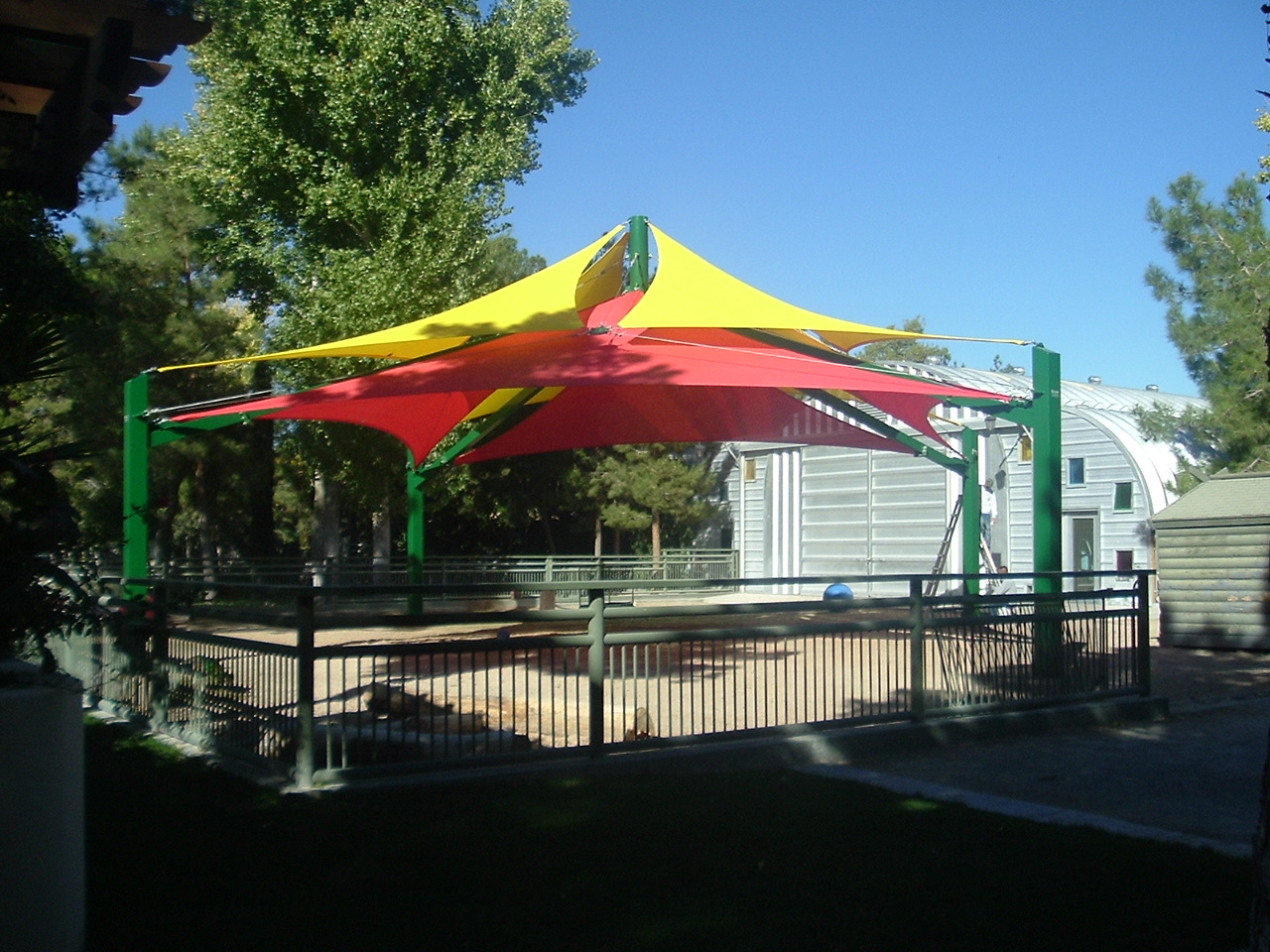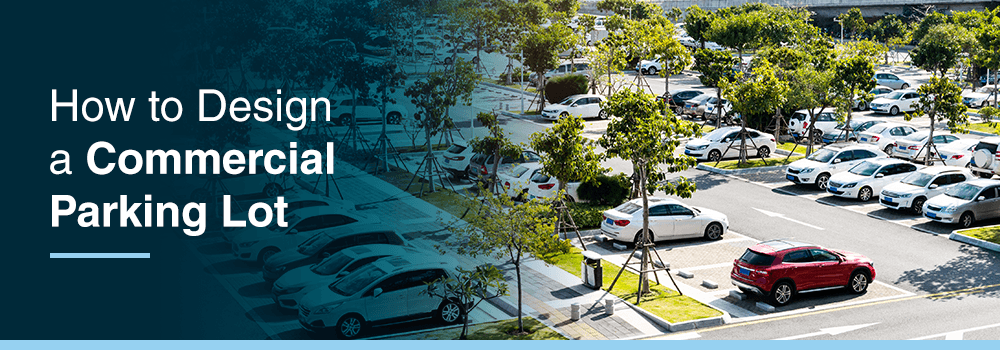

For many commercial businesses, the facility’s parking lot is the first impression. The commercial parking lot — used for both vehicle parking and pedestrian traffic — is the first area any employee, customer or potential customer will encounter before accessing the building complex. Your lot’s conveyed atmosphere can quickly influence a user’s overall feeling about your business.
An effective parking lot design may vary based on its size, function and other needs. Both building architects and landscape architects will need to adapt their commercial parking lot designs for every new customer project. Additionally, they have to understand legal requirements and general guidelines to ensure the plans are functional. From all points, designing a commercial parking lot takes the correct planning to achieve success.
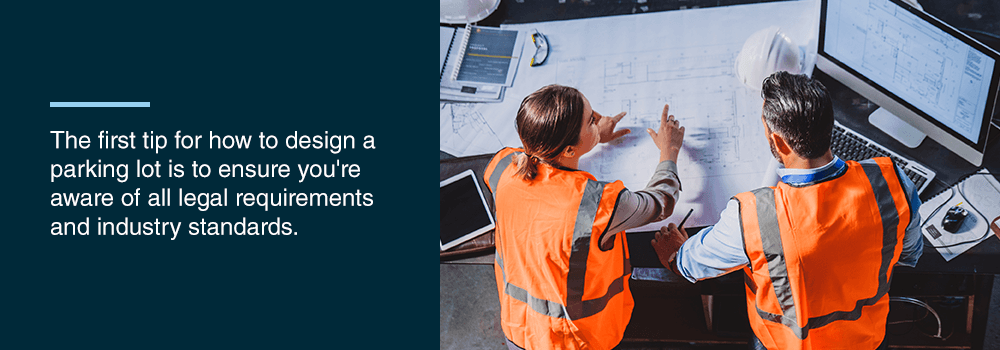

Important Design Considerations for Parking Lots
The first tip for how to design a parking lot is to ensure you’re aware of all legal requirements and industry standards. Many localities have established specific parking lot requirements, varying tremendously between different cities, industries and building types. An architect’s design will need to comply with any vital design considerations, though it must also strive to achieve the customer’s vision.
While the primary intention for any commercial lot is vehicle parking, the facility’s needs will provide more specific insights into the overall design. Essential qualities like safety and convenience should take precedence when designing for the parking lot’s purpose. Let’s take a closer look at these design considerations.
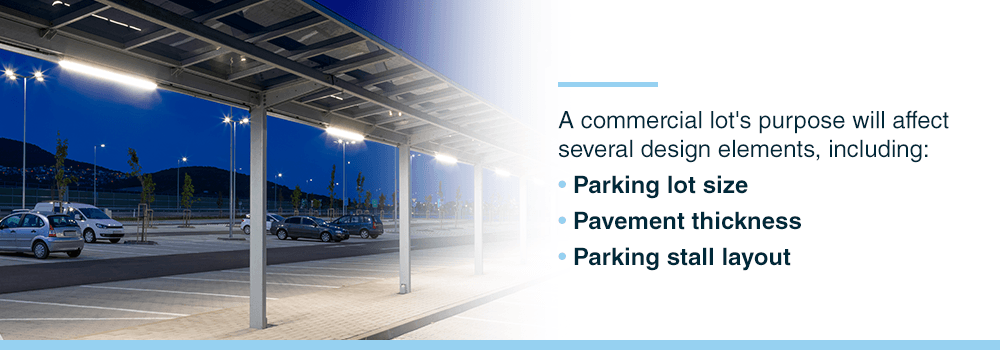

The Lot’s Purpose — Size, Thickness and Layout Standards
Architects can tailor the facility’s required design elements to fulfill the parking lot’s purpose better. Crucial details like parking lot size, pavement thickness and parking stall angles should accurately reflect the type of daily use the lot will endure.
A commercial lot’s purpose will affect several design elements, including:
- Parking lot size: The lot’s required size is most dependent on how many people a facility will need to accommodate at once. Specific industries might use a facility’s square footage to determine the pavement area’s size requirement. Additionally, some buildings may have specific parking code requirements based on capacities, like the number of available seats or rooms. Your design will need to use the industry-recommended or code-required number of parking stalls to determine the minimum dimensions of your parking lot.
- Pavement thickness: The pavement base and surface thickness are dependent on the weight endured by your asphalt daily. The type of vehicles used on the pavement, the weight of shipping loads and the quality of subgrade soil will affect how thick the pavement must be to achieve adequate durability. When you use a minimum pavement thickness design, remember that any reductions below the minimum value may cause severe failures in your asphalt.
- Parking stall layout: The layout of your parking stalls will greatly depend on how people will use the lot. Rows of parking stalls are typically angled at 45, 60 or 90 degrees depending on the lot’s purpose. Angles at 45 to 60 degrees are excellent for facilities with high turnover. Parking stalls at 90-degree angles are more challenging to park in yet achieve the highest passenger car capacity. While the standard size for 90-degree parking stalls is 9-feet-by-19-feet, you might need to provide areas with slightly wider or smaller stalls to serve a particular purpose.
All architects should consider the lot’s purpose before measuring their design elements and defining a layout. This objective will help you optimize space during the planning stage — from calculating the dimensions of your pavement to implementing unique needs like special truck lanes or accessible stalls.
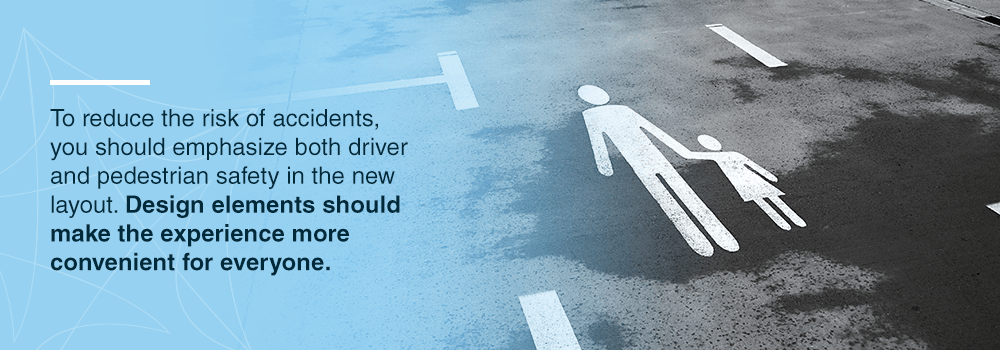

Other Parking Lot Design Considerations
- Entrances and exits: To ensure a functional design, consider the traffic flow into and out of the commercial parking lot. The access opening can influence many vital design elements, such as the optimum angle of individual parking stalls. If the only outlet is less than 30 feet wide, you may even need to plan a separate entrance and exit.
- Pedestrian traffic: Create a commercial lot that caters to drivers and pedestrians. Consider how employees and customers might travel from their parked vehicles to the facility entrance. To reduce the risk of accidents, you should emphasize both driver and pedestrian safety in the new layout. Design elements should make the experience more convenient for everyone.
- Special truck lanes: Certain industries must expedite traffic to loading areas, trash dumpsters and heavy equipment zones. In these cases, the parking lot design may require special truck lanes with a pavement structure that can handle the increased weight. Consider how trucks and other heavy vehicles might use the parking area and install the best pavement thickness.
- Accessibility standards: Ensure your accessible parking spaces have the shortest accessible route to the facility entrance. At least one accessible parking stall is required for all commercial parking lots. However, the minimum number of accessible spaces can be higher depending on the design’s total parking stall amount.
- Pavement drainage: Give special consideration to the parking area’s surface and subsurface drainage. Saturated pavement will quickly lose its strength and stability, causing pavement failure when imposed under heavy loads. It’s best to address asphalt drainage problems early during construction and use different prevention methods in your design.
- Base construction: Consider whether the parking lot pavement should have a full-depth asphalt concrete base or an aggregate base. The subgrade, or ground under the pavement, will need to be graded to the chosen base’s established requirements. You must also compact the subgrade’s surface and correct all deficiencies before constructing the base.
5 Steps for Designing a Commercial Parking Lot
There are a few significant elements that architects must consider when designing a new parking lot. From gathering industry-specific requirements to enhancing the final layout with landscaping, the following steps will help you prepare functional and unique commercial parking lot designs for your customers.
1. Identify the Lot’s Purpose
A parking lot can serve vastly different purposes depending on the facility’s city, industry and building type. A facility with high customer turnover will require a personalized parking lot, distinct from one which only sees a few all-day employees. Once you identify a commercial lot’s purpose, you can better prioritize the most impactful industry standards, building code requirements and general guidelines.
Critical design elements — like parking lot size, pavement thickness and parking stall layout — must comply with the facility’s minimum requirements. Some industries use the facility’s square footage to determine the size requirement, while others use the building type’s capacity. If there’s no recommended method, you can use the building code requirement for parking stall amount and the correct stall dimensions to calculate an ideal pavement area size.
The lot’s purpose can also influence the parking stall angles and minimum pavement thickness. Angles at 45 to 60 degrees are more convenient to park in, while 90-degree angles create a higher car capacity number for the same sized area. Consider whether buses, trucks and other heavy vehicles will need to use the parking area, too. For most parking lots, the heaviest traffic is experienced during construction. Choose a pavement structure that can handle these loads and avoid falling under the minimum thickness value.
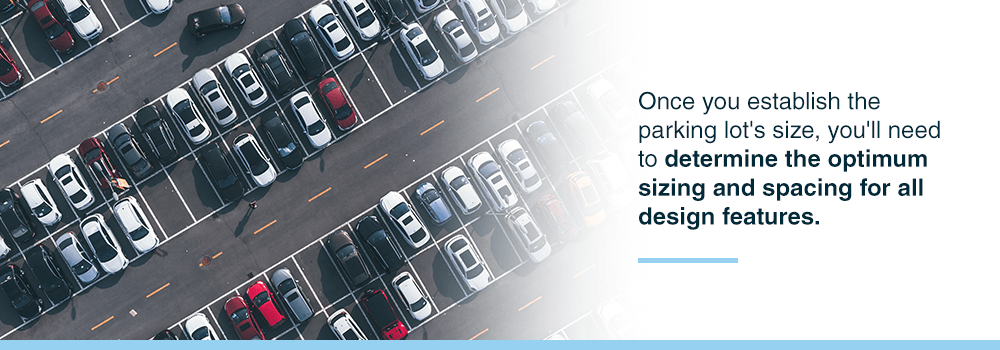

2. Measure Parking Stall Sizing and Spacing
Once you establish the parking lot’s size, you’ll need to determine the optimum sizing and spacing for all design features. Your measurements for parking stalls, two-way traffic lanes and other required amenities should ensure everything fits within the pavement area.
Parking stall angles at 90 degrees are ideal for overnight parking, employee zones and lots with limited space. This angle achieves a higher parking stall capacity, though it makes the stalls more challenging to use. Alternatively, 45 to 60 degrees are excellent for facilities with high turnovers, like gas stations or convenience stores. Ensure your design can fit the enforced number of parking stalls, even if you choose a less convenient angle.
Individual commercial parking stalls should be a minimum of 9 -feet-by-19-feet, though some facilities may need special sections with slightly altered stall sizes. Consider the reason people will be using a parking stall when choosing your layout. Wider stalls are sometimes used when people will be carrying groceries or if the spaces are reserved. An architect may designate a section of slightly smaller stalls — ideal for compact cars or motorcycles — to better utilize the available pavement area.
Two-way traffic lanes have a minimum width of 24 feet. Perimeter circulation road lanes are usually 30 feet wide and provide quick navigation around the lot. Architects can optimize space by using a single traffic lane to serve two rows of parking stalls. Any special truck lanes should be considered based on the class and weight of the vehicles that require them. This step is crucial because it can significantly affect the pavement thickness.
Account for the extra space you’ll need to make the lot more accessible and safe. All commercial parking lots must include the minimum number of accessible parking stalls based on the lot’s total. Accessible parking stalls are typically wider than standard stalls and should be located as close to the entrance as possible. Consider making the lot more accessible with walkways, ramps and curb structures. Record these measurements in your preparations so you’re prepared when it’s time to plan the layout.
After measuring the required parking stalls and lanes, you’ll see how much space is available for other parking lot amenities that are less of a priority. Certain facilities may use their lot to serve additional functions. Determine whether the design needs a truck-loading zone, bus drop-off lane or customer drive-through. These elements could be vital for specific lots and unnecessary in others.
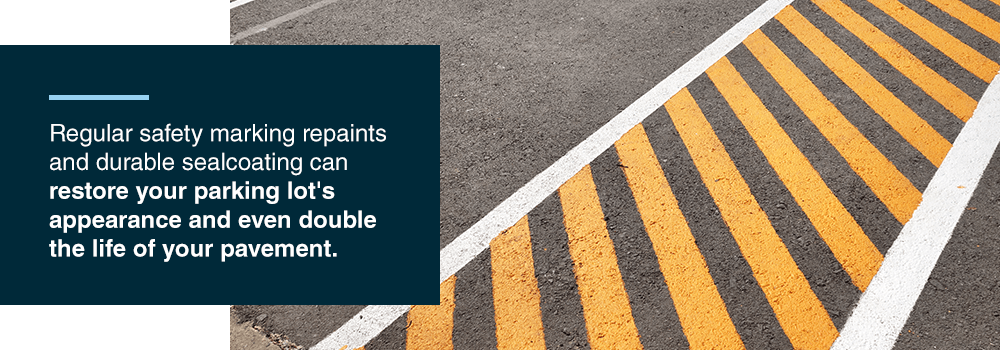


3. Define the Layout With Boundaries
An efficient layout should ensure optimum safety and convenience for everyone. Once you’ve established precise sizing and spacing for all your different elements, the next step is to define the lot’s layout and traffic flow. Consider how drivers and pedestrians will use a parking lot when organizing your aspects into a practical design.
First, use your clearly defined measurements to create a layout. Follow these guidelines to optimize space efficiency:
- Use rectangular pavement areas whenever possible.
- Place parking stalls along the lot’s perimeter.
- Make each parking stall’s long sides parallel.
- Aim to serve two rows of stalls with one traffic lane.
Next, add boundaries to contain your elements and direct traffic through the commercial lot:
- Traffic signage: Provide helpful traffic signs to enhance parking lot safety. Protect pedestrian and right-of-way traffic with stop and yield signs, speed limit markers and pedestrian crossings. Accessible stalls should be visibly marked by a reserved parking sign at a location nearest to the facility entrance.
- Painted markings: Painted asphalt markings are often used to define parking stall boundaries and direct traffic flow. Use stark, visible markers to specify which stalls are van-accessible or paint stripes along the pavement to indicate pedestrian zones.
- Concrete barriers: Adequately placed wheel-stop barriers can protect vehicles and keep them situated safely within the stalls. Prevent damages to landscaping and adjacent buildings with concrete walls along the facility’s perimeter. Place barriers at the front end of parking stalls immediately next to the building complex for increased protection.
Signs, markers and barriers all help reinforce driver and pedestrian safety within your parking lot design.
4. Include Safety Provisions
Incorporate additional security provisions into your layout — even when designing for smaller-scale facilities. Effective small parking lot design will need to incorporate proper drainage, access ramps and possible lighting to ensure all employees and customers on the premises are safe.
Pavement drainage provisions are a crucial consideration of all parking lot designs. Saturated pavement quickly damages the underlying soil, ruining the integrity of your design. Fortunately, you can incorporate surface and subsurface drainage methods that are highly effective when handled early in construction. Add inlets and catch basins to collect the water and keep it from pooling on your asphalt. Prevent water accumulation at the pavement edges by using a slight slope to encourage water runoff.
Your specifications should account for any elevation changes to ensure the asphalt is applied uniformly. Build access ramps into the perimeter curb at the building’s entrance and any other asphalt-marked pedestrian zones. This way, the design ensures a safe and accessible path from the pavement to the elevated sidewalks around the facility.
Effective lighting design allows the commercial lot to be safe and operational at any time of day. This safety provision is essential for facilities that remain open after sunset and need to provide adequate vision and excellent coverage throughout the lot. Light fixtures should help employees and customers feel more comfortable when traveling to their vehicles. Heavier lighting can improve protection in highly trafficked areas such as entrances, exits and loading zones. Angle the stream of light downward, as close to zero degrees as possible, to reduce light pollution and glare.



5. Upgrade With Other Design Elements
In addition to the required design elements and construction-related safety measures, your design can include various other features that will enhance the lot’s quality. Beautify the parking lot with practical landscaping and maintain professionalism with regular sealcoating.
Strategic tree placement and other landscaping techniques can work wonders both in and around your parking lot. Well-maintained greenery will boost your lot’s visuals, adding color to the industrial appearance of asphalt and concrete. Trees can also serve practical functions such as offering shade to walkways or helping with water drainage. Remember that landscaping will require regular upkeep and adequate space to grow. Smaller parking lots may lack the space needed for a tree, though smaller shrubs and other techniques could still benefit your design.
Long-term care and maintenance provisions — for any parking lot upgrades and the pavement itself — will protect your parking lot design so it remains appealing and operational. Consistent effects of water, wind, dripping oil and ultraviolet rays can wear down the pavement over time. Regular safety marking repaints and durable sealcoating can restore your parking lot’s appearance and even double the life of your pavement. Stark asphalt markings look clean and professional. The enhanced visibility will keep your drivers safe, while proper protection methods help weatherproof and sun-proof your final design.
Products to Enhance Your Commercial Parking Lot Design
Your commercial parking lot designs must bring lasting benefits to a variety of customers. As you take on new design projects, you’ll want to prepare various tools you can utilize in diversified industries and settings. Explore unique features and products that will advance your design potential.
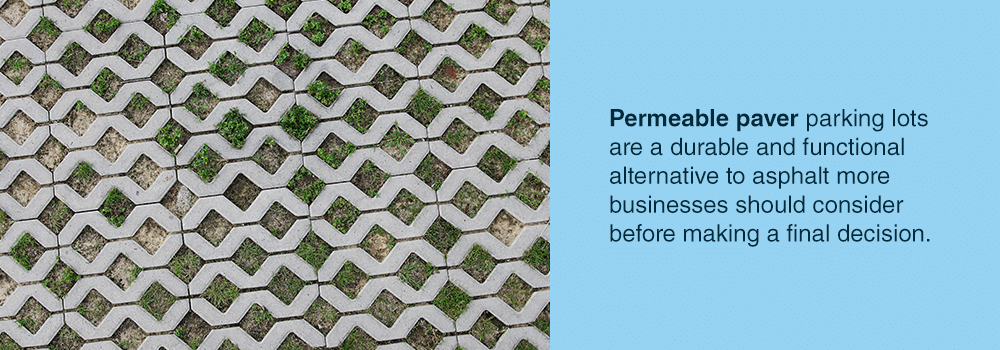

Permeable Paver Parking Lots
For years, businesses have used asphalt for their commercial parking lot designs. Despite the many alternatives available in 2021, asphalt is still a standard used by many architects and landscape architects. Permeable paver parking lots are a durable and functional alternative to asphalt more businesses should consider before making a final decision.
Permeable paver parking lots offer several benefits that asphalt cannot provide:
- Easy drainage: Permeable lots operate as natural water drainage systems. They absorb heavy rains instantly and lead the water directly into the soil below. Asphalt requires you to design a drainage system which can take time and additional expenses from other parking lot features.
- Customizable: Asphalt parking lots are typically only available in black, with the stylistic options including white or yellow lot lines and painted markings. Permeable pavers can be delineated in various colors and filled with any color gravel. Your parking lot design can perfectly complement the building complex.
- Sustainable: Commercial paver parking lots come in an eco-friendly grass variety. Permeable pavers provide a durable and functional design without using toxic sealants and water pollutants. Asphalt lots are a much less sustainable option.
- Durable: Permeable paver parking lots require less maintenance. Asphalt parking lots typically have recurring maintenance costs from fading lot lines and pavement failures. The permeable paver’s spots parking markers present a quick, durable way to stripe your lot.
Compare the available asphalt alternatives to ensure your designs use the best materials for the project.
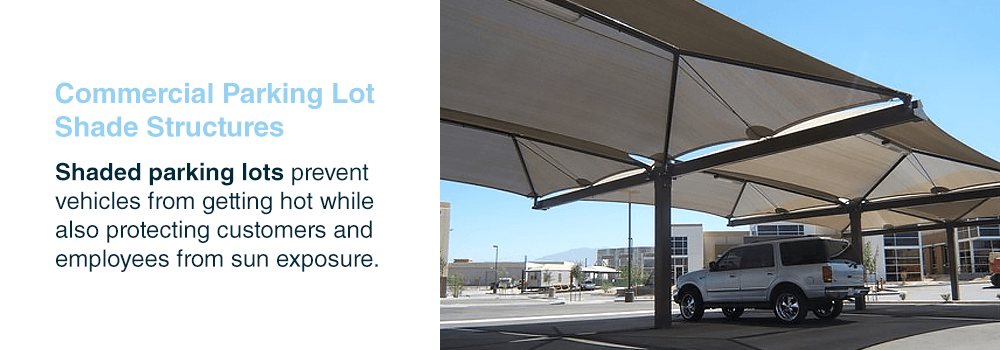

Commercial Parking Lot Shade Structures
Providing adequate shade can be a crucial design element for many commercial parking lots. The vast, open space and dark-colored pavement attract heat throughout the day. Shaded parking lots prevent vehicles from getting hot while also protecting customers and employees from sun exposure.
Some architects use trees and other landscaping techniques to offer shade, though these features require long-term care and may provide an unpredictable amount of shade. Custom shade solutions offer more control to the designer and bring consistent shade to any project. Efficiently integrate customized fabric structures into your parking lot designs with support from the USA SHADE Architectural Specialist Division — your customers will appreciate the added shade and the use of industry trends in fabric architecture.
Fabric structures provide year-round coverage to sunlit areas and may extend the times for customers to use the facility. When customers know their car will have a shaded stall, they’re more likely to visit your parking lot — even during unbearably hot days. Shade structures offer both functional and aesthetic value to a project.
Fabric architecture serves as a visual upgrade to any outdoor area. Our unique structures can transform your parking lot design with practical shade solutions and distinct, eye-catching styles. Make your mark with techniques and products that help your customers build their brand. Parking lots are a place to store vehicles, but they can also attract talent, intrigue customers and improve a facility’s growth.
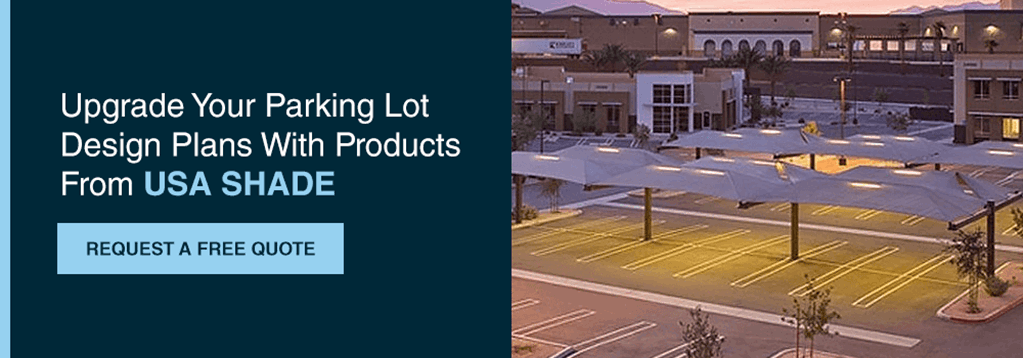

Upgrade Your Parking Lot Design Plans With Products From USA SHADE
Collaborate with USA SHADE & Fabric Structures for your next parking lot design project. Our architects, landscape architects and other design professionals are happy to offer support with current fabric architecture and shade design trends. We provide shade solutions that lead to successful projects and lasting partnerships.
Request a quote for USA SHADE’s commercial parking lot shade structures to enhance your design plans. Our custom capabilities will help you bring your vision to reality.


